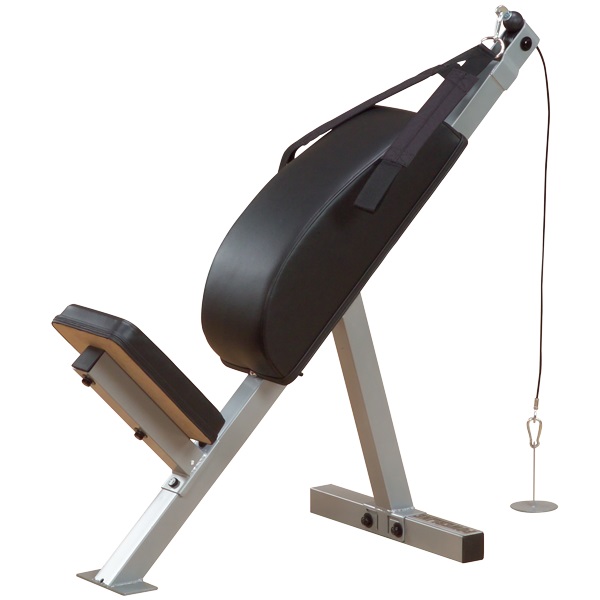Steve Holman
Question: Help! I need abs fast. Can you give me the perfect routine so I don't waste time?
Answer: Getting abs is more than just using the perfect routine. You also have to have a bodyfat level that's below 10%, which can be difficult. With that said, let's focus on a routine.
Working your rectus abdominus through a full range of motion is key. That means from a position at which your lower back is arched, to where your torso is crunched forward, completely contracting your abs. The easiest way to accomplish that is with an Ab Bench.
http://ditillo2.blogspot.com/2015/12/ab-bench-q-and-fred-hatfield-1995.html
It trains your rectus abdominus from full stretch to complete contraction - but you must be careful not to jerk or heave your torso forward. Make your reps smooth and fairly slow so you feel your abdominals working. Also, you may want to hold the crunch position and blow the air out of your lungs to force an even harder contraction.
Ab Bench From Ironman
The Bodysolid Ab Bench.
Rogue Ab Mat
Rolled Up Towel
The Ab Bench crunch pull is an exercise that very concentrated and isolated. Most of us know, however, that you need compound movements for complete development. It's the reason squats build more muscle than leg extensions. Therefore, I suggest you do two sets of regular situps or incline or hanging knee-ups before your Ab Bench crunch pulls. If you choose the latter don't forget the hip curl at the end of each rep so you're not just working your hip flexors.
If you don't have an Ab Bench, you can do a similar movement a bench press bench (or lying belly up on a hyperextension unit). Lie on your back, place your feet up on the bar and scoot back until your upper back is hanging off the end of the bench. Don't go too far with the angle of the back when it's hanging like this. Once you need to add weight, you'll have a small problem. That's why the Ab Bench was invented - comfortable, progressive resistance, full range exercise. If you can get one for home or talk your gym owner into getting one, use it.
Question: I keep hearing I should train a muscle from "all the angles" if I want it to be its biggest and fullest. How can I find out what "all the angles" are for every muscle?
Answer: I don't think I've ever received such a perfect question for reviewing the Positions of Flexion mass-building concept - so here goes.
Just about every muscle has what I refer to as an arc of flexion. It's a range with a number of points at which a muscle can contract. For example, you can work your triceps with overhead extensions, lying extensions, and pushdowns, so the arc of flexion is from an arms overhead position to an arms at your sides, or slightly behind your torso, position. It would be like doing a machine pullover but being able to bend your arm at the elbow and extend the lower arm anywhere along the range of motion to work your triceps.
What you have with the above example is three different exercises to cover "all the angles" for the triceps:
Overhead extensions: Stretch position
Lying extensions: Midrange position
Pushdowns: Contracted position.
Stretch, midrange, and contracted POF (Positions of Flexion) exercise designations for each bodypart, that enable you to train the muscle through a full range of motion. Another example is for biceps:
Incline dumbbell curls: Stretch
Barbell curls: Midrange
Concentration curls: Contracted.
The biceps and triceps are probably the easiest to understand as far as arc of flexion is concerned, but if you think about it, you can probably figure out the three positions for each bodypart. Some muscles require only two exercises to cover the three positions.
for example, for hamstrings you use stiff legged deadlifts to hit the midrange AND stretch positions - stretch is near the bottom and midrange is near the top, where the glutes and lower back exert the most power - and leg curls to work the muscle in the contracted position.
For chest you divide it into upper and lower sections, but it's still not complex. You do incline cable flyes to work the upper-chest stretch and contracted portions, and incline presses to train the midrange position. For lower chest you do decline cable flyes to train the stretch and contracted positions and bench presses to work the midrange position.
You may think back is a bit more complex, but once you divide it into lats and midback, the positions become clearer.
Lats
Midrange: chins or pulldowns
Stretch: pullovers
Contracted: stiff-arm pulldowns.
Midback
Midrange: behind the neck pulldowns
Stretch: close-grip cable rows
Contracted: bent arm bentover laterals.
There are a number of variations of the above. I've included a complete Positions of Flexion overview in the training section at the IronMan website. Some exercise selection examples for the three positions can be found here:
http://pjlusa-exercise.blogspot.com/2006/01/positions-of-flexion-by-steve-holman.html
The book "Critical Mass" gives a good introductory exercise-by-exercise POF description for each bodypart along with a number of complete routines. There's lots of books out there relating to POF training variations.
By the way, the standard working order to the three positions is midrange first, stretch, then contracted. That's the straight-set POF approach, but there are many hybrids, such as Hypercontraction (stretch position first) and Compound Aftershock (various superset combinations).
If you're interested in building the fullest muscle structures as quickly as possible, I suggest you become familiar with POF's full-range concept for each bodypart. You'll cover all the angles and make gains with that simple yet powerfully effective muscle-building approach.





No comments:
Post a Comment